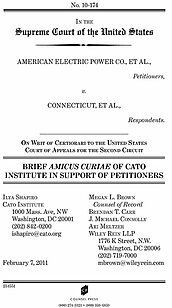American Electric Power Co. v. Connecticut
Learn more about Cato’s Amicus Briefs Program.
As Congress debates cap-and-trade, new fuel standards, and subsidies for “green” companies, some still feel that political solutions to global warming are not moving fast enough. In the present case, eight states and New York City sued several public utilities (including the federal Tennessee Valley Authority), alleging that their carbon dioxide emissions contribute to global warming. This is the third major lawsuit to push global warming into the courts (another being Comer v. Murphy Oil USA, in which Cato also filed a brief). All of these suits try to use the common law doctrine of nuisance — which, for example, lets you sue your neighbor if his contaminated water flows onto your land and kills your lawn — to attack carbon emitters. None of them had gotten very far until the Second Circuit vacated a lower-court ruling and allowed the claims here to proceed. But the judiciary was not meant to be the sole method for resolving grievances with the government — even if everything looks like a nail to lawyers who only have a hammer. After all, there are two other co-equal branches, the legislative and executive, which are constitutionally committed to unique roles in our system of separation of powers. The doctrine of “standing” exists in part to ensure that the judiciary is not used to solve issues that properly belong to those other branches. Toward this end, the Constitution allows courts to hear only actual “cases or controversies” that can feasibly be resolved by a court. Cato thus filed a brief supporting the defendant utilities’ successful request for Supreme Court review, and has now filed another brief supporting their position before the Court. Cato’s latest brief first argues that no judicial solution is possible here because the chain of causation between the defendants’ carbon emissions and the alleged harm caused by global warming is so attenuated that it resembles the famed “butterfly effect.” Just as butterflies should not be sued for causing tsunamis, a handful of utility companies in the Northeastern United States should not be sued for the complex (and disputed) harms of global warming. Second, we contend that, even if the plaintiffs can demonstrate causation, it is unconstitutional for courts to make nuanced policy decisions that should be left to the legislature — and this is true regardless of the science of global warming. Just as it’s improper for a legislature to pass a statute punishing a particular person (bill of attainder), it’s beyond courts’ constitutional authority — under the “political question doctrine” — to determine wide-ranging policies in which numerous considerations must be weighed in anything but an adversarial litigation process. If a court were to adjudicate the claims here and issue an order dictating emissions standards, two things will happen: 1) the elected branches will be encouraged to abdicate to the courts their responsibilities for addressing complex and controversial policy issues, and 2) an already difficult situation would become nearly intractable as regulatory agencies and legislative actors butt heads with court orders issued across the country in quickly multiplying global warming cases. These inevitable outcomes are precisely why the standing and political question doctrines exist. Dissatisfaction with the decisions and pace of government does not give someone the right to sue over anything. Or, as Chief Justice Marshall once said, “If the judicial power extended to every question under the laws of the United States … [t]he division of power [among the branches of government] could exist no longer, and the other departments would be swallowed up by the judiciary.”

This work is licensed under a Creative Commons Attribution-NonCommercial-ShareAlike 4.0 International License.

